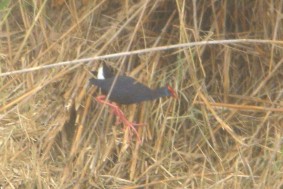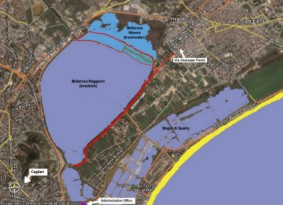| Back to Homepage |
 |
|
Birdwatching at Molentargius and the Stagni di Quartu |
|
|
Molentargius is probably the most famous of
Sardinia's birdwatching locations, and justifiably so. What's more,
it's very close to the centre of Cagliari, and easy to get to.
It consists of two main pools; Bellarosa Minore to the north east, a
smaller freshwater pool and Bellarosa Maggiore to the south west, a much
larger brackish pool. In between these 2 pools, there are numerous
reed-filled freshwater pools and canals. Both to the south, and along
the coast, to the south east, there are many other pools, including the
Stagni di Quartu, used in the past to produce salt.
Breeding/ Resident species at Molentargius include Purple Swamp Hen (which is here in very good numbers), Squacco Heron, Purple Heron and Night Heron, Cattle Egret and Little Egret, Slender-billed Gull, Gull-billed Tern, Little Tern and Common Tern, Ferruginous Duck, Shoveler, Pochard, Gadwall, Greater Flamingo, Black-winged Stilt, Avocet, Common Sandpiper, Kingfisher, Spotless Starling, Zitting Cisticola, Reed Warbler, Serin, Kingfisher, Marsh Harrier. Kentish Plover, Black-headed Gull and Audouin's Gull can be seen at quieter times of the year around the Stagni di Quartu and along the beach. The pools are also very good for migrant species, including Glossy Ibis, Spoonbill, Garganey, Hoopoe, Spotted Redshank and plenty of other waders. Wintering species include Red-crested Pochard, Shelduck, Spoonbill and Grey Heron. Tips for Seeing the Purple Swamp Hen These birds are much more active at dawn, so getting to the reserve early is a good idea. Nonetheless, there are so many at Molentargius, that they can be seen all year round with little difficulty. They only like freshwater, so spend time scanning the reedbeds and freshwater canals between Bellarosa Minore and Bellarosa Maggiore and also the pools to the north west of Bellarosa Minore. They are quite secretive and are quick to take cover. Getting to Molentargius Despite being very close to the centre of Cagliari, many birdwatchers have complained that it is very difficult to find the roads that lead onto the reserve. If you're travelling by car, the easiest way is from the east. Depending on exactly where you're are coming from, follow the signs to Quartu Sant'Elena, the town to the east of Cagliari. If you are coming from Cagliari, there is a busy orbital road, that will take you right around the north side of Molentargius. However, there are no access roads on this side. Once you get to Quartu Sant'Elena, find the Viale Cristoforo Colombo (which runs down to the beach) and take Via Giuseppe Parini, from the middle of the town heading southwest (on your right if you've come from Cagliari). Follow this road along until it turns into a dirt track. Keep going until you see Molentargius behind a metal fence on your right. The metal fence prevents access during breeding season, but there are several gates, which are sometimes open. You can park anywhere along this road, or if access is allowed (see below), you can drive onto the tracks between Bellarosa Maggiore and Minore. If you want to try to get a pass (easier if you speak Italian), head for the administration office to the south west of the pools (see below for details). If you don't have a car, it's possible to walk to Molentargius from the centre of Cagliari (3-4km) as long as you have a fairly detailed map. When you get close to the reserve, just follow one of the dirt tracks that lead onto the area. Joggers and dog walkers can point you in the right direction if you get lost. Regular buses go from Cagliari to Quartu Sant'Elena, from where you can access the reserve (see instructions for cars above). Access to Molentargius At the time of writing (2006), access to the two main pools is restricted due to possible disturbance to the birds (Molentargius is a Ramsar Wetlands site). They have recently been fenced off and beautiful new hides have been built, along with some impressive information boards, which all look promising for the future, although the wardens were not able to tell me exactly when the work would be completed and what kind of access would be allowed to the public in the future. Currently, day and longer passes can be issued to birdwatchers, although I'm not sure if they speak English at the administration office. The official name of the body which runs the reserve is the Consorzio del Parco Naturale Regionale "Molentargius-Saline", and the administration office is located a long way away from the 2 main pools at the far south west of the 'area' (see map). It's a 3- storey yellow building with a red tiled roof, which can be seen on the left on Via La Palma if you are exiting the site on the Cagliari side, just after a small bridge. Once you've found the building, you need to go up to the second or third floor and ask around. If you are visiting at the weekend (when the administration office is closed), or you don't want to bother with the hassle of getting a permit, you can see some birds by skirting around the lake on the dust roads to the south of it. Access to Bellarosa Minore is also possible from the east side by following a track that leads off to the right if you are entering the site from the Quartu side (this track is indicated on the map).
|
Purple Swamp Hen at Molentargius
Click on map to open a larger version in a new window |
|
Stagno di Santa Gilla If you take a quick look at a map of the Cagliari area, you'll see a massive area of wetlands directly to the west of the city. The main stagno, called Stagno di Cagliari is very big, quite deep and rarely has any birds on it. Further west there is a network of shallow saline (salt pools), called the Saline di Santa Gilla, and at the western end of this body of pools, near to Capoterra (and sometimes called the Stagno di Capoterra), is the Stagno di Santa Gilla. The saline are in fact home to the largest breeding population of flamingos in Sardinia, and one of the largest flamingo breeding colonies in Europe. This is well worth seeing, but access is difficult, as the birds have wisely chosen to nest in the middle of the most inaccessible stagni complex. However, at all times of the year, lots of flamingos can be seen on almost all the stagni in this area. These stagni are too saline to support many other species of birds, so the best birdwatching site this side of Cagliari is the Stagno di Santa Gilla, which has excellent access for birdwatching, and at some times of the year can hold a nice variety of species. Access to the Stagno di Santa Gilla Follow the coastal road from Cagliari south west towards Pula. You will soon see the saline on your right. There are several lay-bys to stop in and scan the pools for birds. You'll come to a roundabout after quite a distance. Go straight on. Just after the roundabout there is a long industrial pier stretching out into the sea. Slow down as you drive under the bridge that leads to the pier, and take the first track to the right, directly after the pier (the entrance is almost hidden). You'll find yourself immediately in the car park. Park here and explore along the walkway. The further you go, the fresher the water gets. There is a well positioned tower hide about 1km from the car park.
|
Species at the Stagno di
Santa Gilla Species here are similar to those at Molentargius, although there is very little fresh water here, so species such as Purple Swamp Hen are absent. Flamingo, Great Egret (winter or migrant), Spoonbill (winter mainly), Little Egret, Grey Heron (winter), Teal, Wigeon (winter), Grey Plover (winter), Avocet, Greenshank, Slender-billed Gull (summer), Gull-billed Tern (summer), Water Pipit (winter), Zitting Cisticola.
|

